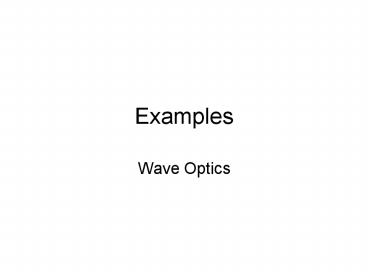Examples - PowerPoint PPT Presentation
1 / 12
Title:
Examples
Description:
Examples Wave Optics Examples Wave Optics 1- A double-slit experiment is set up using a helium-neon laser ( = 633 nm). Then a very thin piece of glass ( n= 1.50 ... – PowerPoint PPT presentation
Number of Views:449
Avg rating:3.0/5.0
Title: Examples
1
Examples
- Wave Optics
2
1- A double-slit experiment is set up using a
helium-neon laser ( ? 633 nm). Then a very thin
piece of glass ( n 1.50 ) is placed over one of
the slits. Afterward, the central point on the
screen is occupied by what had been the m 10
dark fringe. How thick is the glass?
3
(No Transcript)
4
(No Transcript)
5
2- Light of wavelength 600 nm passes through a
double slit and is viewed on a screen 2.0 m
behind the slits. Each slit is 0.040 mm wide and
they are separated by 0.200 mm. How many bright
fringes are seen on the screen?
6
- 3- Light consisting of two nearly equal
wavelengths ? ?? and ?, where ?? ltlt ? , is
incident on a diffraction grating. The slit
separation of the grating is d. - Show that the angular separation of these two
wavelengths in the mth order is
7
b. sodium atoms emit light at 589.0 nm and 589.6
nm. What are the first-order and second-order
angular separations ( in degrees) of these two
wavelengths for a 600 line/mm grating?
8
4- The Figure shows two nearly overlapped
intensity peaks of the sort you might produce
with a diffraction grating . As a practical
matter, two peaks can just barely be resolved if
their spacing ?y equals the width w of each peak,
where w is measured at half of the peaks height.
Two peaks closer together than w will merge into
a single peak. We can use this idea to understand
the resolution of diffraction grating.
- In small angle approximation, the position of the
m1 peak of diffraction grating falls at the same
location as the m 1 fringe of a double slit y1
?L/d. Suppose two wavelengths differing by ??
pass through a grating at the same time. Find an
expression for ?y, the separation of their
first-order peaks.
9
B. We noted that the widths of the bright fringes
are proportional to 1/N, where N is the number of
slits in the grating. Lets hypothesize that the
fringe width is w y1 / N. Show that this is
true for the double-slit pattern. Well then
assume it to be true as N increases.
10
c. Use your results from parts a and b together
with the idea that ?ymin w to find an
expression for ??min, the minimum wavelength
separation ( in first order ) for which the
diffraction fringes can barely be resolved.
d. Ordinary hydrogen atoms emit red light with a
wavelength of 656.45 nm. In deuterium, which is a
heavy isotope of hydrogen, the wavelength is
656.27 nm. What is the minimum number of slits in
a diffraction grating that can barely resolve
these two wavelengths in the first-order
diffraction pattern?
11
- 5. The Figure shows a plane wave approaching a
diffraction grating at angle ?. - Show that the angles ?m for constructive
interference are given by the grating equation - Angles are considered positive if they are above
the horizontal line, negative if below it.
12
b. The two first-order maxima, m 1 and m -1,
are no longer symmetrical about the center. Find
?1 and ?-1 for 500 nm light incident on a 600
line/mm grating at ? 30.































